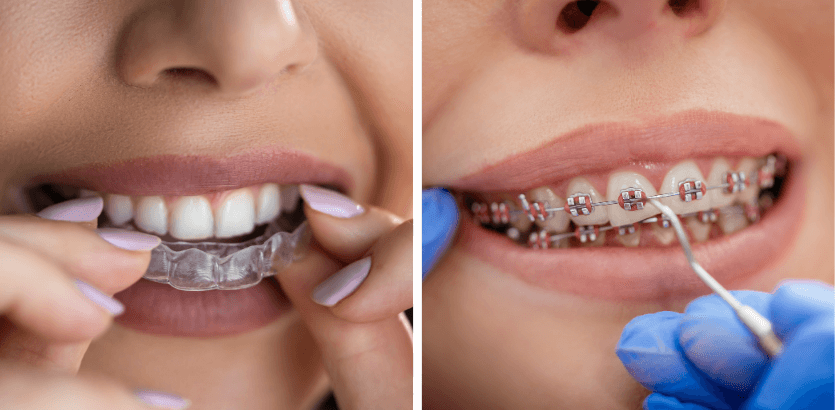
In the realm of orthodontic treatment, the choice between clear aligners and traditional braces can be pivotal in achieving the desired smile. Each method offers distinct advantages and considerations, catering to different preferences and needs. Clear aligners, hailed for their discreet appearance and removable nature, have revolutionized orthodontic care. These custom-made trays gently shift teeth into alignment, offering a less conspicuous alternative to traditional braces.
Conversely, traditional braces, characterized by metal brackets and wires, remain a steadfast option known for their effectiveness in treating a wide range of orthodontic issues. In this blog, we delve into the nuances of clear aligners versus traditional braces, aiding you in making an informed decision about which option aligns best with your goals and lifestyle.
By understanding the unique features and benefits of each treatment modality, you’re equipped with the knowledge to navigate the decision-making process effectively.
What Are Clear Aligners?
Clear aligners are transparent, custom-made trays designed to gradually straighten teeth and correct orthodontic issues. Here’s a closer look at how they work and the benefits they offer:
- Clear aligners utilize a series of custom-fitted trays, each slightly adjusted to incrementally shift teeth into proper alignment over time.
- These trays are typically made of smooth, BPA-free plastic, ensuring comfort and minimizing irritation to the gums and soft tissues.
- Unlike traditional braces, clear aligners are removable, allowing for easier oral hygiene maintenance and the ability to eat and drink without restrictions.
- Clear aligners offer a discreet orthodontic solution, virtually invisible when worn, making them an appealing option for individuals seeking a more aesthetically pleasing treatment.
- With clear aligners, there are fewer visits to the orthodontist compared to traditional braces, as there’s no need for adjustments or wire tightening.
- Clear aligners are ideal for correcting mild to moderate orthodontic issues, including crowded teeth, gaps, overbites, underbites, and crossbites.
Overall, clear aligners provide a convenient, comfortable, and inconspicuous orthodontic treatment option, offering patients the freedom to achieve a straighter smile without the limitations associated with traditional braces.
Understanding Traditional Braces
Traditional braces are a time-tested orthodontic treatment method that involves metal brackets and wires to straighten teeth. Here’s a breakdown of how they work and their main components:
- Traditional braces use metal brackets bonded to the teeth, connected by archwires that apply gentle pressure to gradually shift teeth into proper alignment.
- Elastic bands, or ligatures, are used to secure the archwires to the brackets, allowing for precise control over tooth movement.
- Brackets are typically made of stainless steel or ceramic materials, while archwires are usually made of metal alloys such as nickel-titanium.
- Traditional braces can effectively address various orthodontic issues, including crooked teeth, overcrowding, gaps, and bite misalignments.
- Regular adjustments are required throughout treatment to tighten the archwires and facilitate tooth movement.
- While effective, traditional braces are more noticeable than clear aligners, as they are visible when smiling or speaking.
Despite advancements in orthodontic technology, traditional braces remain a popular choice for many patients due to their effectiveness in correcting a wide range of dental issues.
Key Differences Between Clear Aligners and Traditional Braces
Clear aligners and traditional braces are both effective orthodontic treatments, but they have distinct differences in appearance, comfort, treatment duration, and effectiveness:
Appearance
- Clear aligners are virtually invisible, made of transparent plastic that fits snugly over the teeth. They provide a discreet orthodontic option, making them popular among adults and teens who prefer a less noticeable treatment.
- Traditional braces, on the other hand, consist of metal brackets and wires that are visible when smiling or speaking. While some patients embrace the traditional look of braces, others may feel self-conscious about their appearance.
Comfort and Convenience
- Clear aligners offer greater comfort as they are custom-made to fit the patient’s teeth snugly. They have smooth edges and do not involve wires or brackets that may cause irritation or discomfort.
- Traditional braces may initially cause discomfort or irritation due to the presence of metal brackets and wires. Patients may experience soreness after adjustments, although this typically subsides within a few days.
Treatment Duration and Effectiveness
- Clear aligners typically have a shorter treatment duration compared to traditional braces, with an average treatment time ranging from 6 to 18 months, depending on the complexity of the case.
- Traditional braces may require longer treatment durations, often ranging from 18 months to 3 years, depending on the severity of the orthodontic issues.
- Both clear aligners and traditional braces are effective in correcting various orthodontic problems, including crooked teeth, gaps, overcrowding, and bite misalignments. However, the effectiveness may vary depending on the individual case and the patient’s compliance with treatment.
Cost
- The cost of clear aligner treatment may be higher than traditional braces, depending on the brand and the complexity of the case. However, many patients find the aesthetic benefits and convenience of clear aligners worth the investment.
- Traditional braces are typically more cost-effective than clear aligners, making them a popular choice for patients seeking affordable orthodontic treatment options.
Ultimately, the choice between clear aligners and traditional braces depends on factors such as personal preference, treatment goals, and the recommendation of the orthodontist.
Factors to Consider When Choosing Between Clear Aligners and Traditional Braces
When deciding between clear aligners and traditional braces, several factors should be considered to ensure the most suitable treatment option:
Severity of Orthodontic Issues:
- Clear aligners are generally effective for mild to moderate orthodontic problems, such as mild crowding, minor spacing issues, and slight bite misalignments.
- Traditional braces are more versatile and can address a wider range of orthodontic issues, including severe crowding, significant spacing, complex bite problems, and jaw alignment issues.
Personal Preferences and Lifestyle Factors
- Clear aligners are removable, allowing patients to take them out for eating, drinking, brushing, and flossing. They offer greater flexibility and convenience for those with active lifestyles or special events.
- Traditional braces are fixed appliances that require adjustments by an orthodontist. While they may be less convenient in terms of maintenance and dietary restrictions, some patients prefer the reliability and predictability of traditional braces.
Cost Considerations and Insurance Coverage
- The cost of orthodontic treatment varies depending on factors such as the complexity of the case, the duration of treatment, and the type of appliance chosen.
- Clear aligners tend to be more expensive than traditional braces due to factors such as materials, manufacturing processes, and treatment duration. However, some insurance plans may cover a portion of the cost for both types of treatment.
- Traditional braces may be more affordable for some patients, especially if insurance coverage is limited or if cost is a significant concern.
Consultation with an Orthodontist:
- It is essential to consult with a qualified orthodontist to evaluate your specific orthodontic needs and discuss the most appropriate treatment options.
- During the consultation, the orthodontist will assess factors such as the condition of your teeth, jaw alignment, facial structure, and treatment goals to recommend the most suitable option.
The decision between clear aligners and traditional braces should be based on a comprehensive evaluation of these factors, along with input from your orthodontist. By considering your individual needs, preferences, and budget, you can make an informed decision to achieve a healthy, beautiful smile.
The decision between clear aligners and traditional braces hinges on various factors like orthodontic issues severity, lifestyle preferences, and financial considerations. Consulting with an experienced orthodontist like Dr. Davidson and the team at Newton Dental Studio is crucial for personalized guidance. Regardless of the choice made, both options can lead to effective orthodontic treatment and ultimately, a confident smile. Remember, the key is to prioritize what aligns best with your needs and goals.



